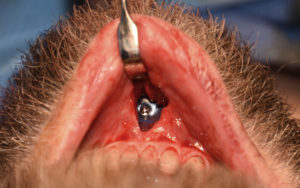The most common alloplastic facial augmentation procedure is a chin implant. Synthetic chin augmentation has been around for over fifty years using a wide a wide variety of materials. But regardless of the material used, there are only two methods of surgical insertion, intraoral or submental incisions.
While to a large degree the location of the chin augmentation incision is simply a method to provide access to do the same thing once one gets there (subperiosteal pocket dissection) there are differences in these incisional approaches. The scar location is the most obvious with the intraoral technique creating an invisible scar with its superior directional approach.
But unlike the inferior submental skin approach which goes through insertion of the mentalis muscle, the intraoral approach must cur through that muscle’s origin. That may seem like a trivial difference but it is not. When cutting through the muscle origin to gain access to place the implant, the muscle must be sewn back together during closure. It is this re-establishment of the muscle origin that can lead to postoperative chin tightness and labiomental deepening/contracture.

By preserving most of the mentalis muscle attachment the risk of chin tightness and other related muscle problems can be largely averted in intraoral chin implant placement.
Dr. Barry Eppley
Indianapolis, Indiana


